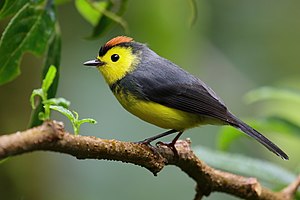Collared Wood Warbler
| Collared Wood Warbler | ||||||||||||
|---|---|---|---|---|---|---|---|---|---|---|---|---|

Collared Warbler ( Myioborus torquatus ) |
||||||||||||
| Systematics | ||||||||||||
|
||||||||||||
| Scientific name | ||||||||||||
| Myioborus torquatus | ||||||||||||
| ( SF Baird , 1865) |
The Collared Wood Warbler ( Myioborus torquatus ) is a small songbird in the genus Myioborus from the Wood Warbler family (Parulidae). The species is endemic to Costa Rica and western Panama . The IUCN lists the bird as "not endangered" (least concern).
features
Appearance
Collared wood warbler reach a body length of 13 centimeters and an average weight of 10.5 grams. The wing length is 5.7 to 6.8 centimeters in the males and 6.0 to 6.6 centimeters in the females. Adult birds have black crown plumage with a large prominent reddish-brown crown spot. The reins , the sides of the head and the throat plumage are light yellow. The eyes are dark. The nape of the neck is black and the sides of the neck and the upper side plumage are dark gray. The wings are blackish with narrow gray edges and the control feathers blackish with extensive white outer feathers.
The most striking feature is the dark gray band over the neck and upper chest area. The underside plumage is light yellow and the under tail-coverts are pale yellowish-white. The beak and legs are blackish. In the worn plumage, the control feathers and the wings can appear slightly brown.
In the youth dress the head and upper side plumage as well as the throat and chest plumage are dark gray. The upper side plumage is washed out brown. The medium and large arm covers have brown hems. The posterior underside plumage is pale yellowish.
Voice and singing
The voice is a high-pitched "tzip". It is more alert than the larval wood warbler ( Myioborus miniatus ), which occurs in the same range.
The song is similar to that of the larval wood singer, but it is lighter, longer, more melodic and variable. Sometimes the singing includes trills and whistles.
Habitat, Nutrition and Reproduction
Collared Warblers inhabit mossy mountain forests, preferably oak forests; Furthermore, bushy gorges, forest edges and high pastures above 1500 meters to the tree line . The populated altitude varies within Costa Rica. In the northern Cordillera de Tilarán it is usually over 1500 meters, to the east in the subsequent Cordillera Central mostly above 2200 meters and south in the Cordillera de Talamanca , which extend into the southeast of Panama, usually over 2500 meters.
Their diet consists of insects. They look for these in pairs in all vegetation heights or catch them in flight. Often they pounce on prey that are frightened up by other birds or sometimes follow herds of cattle in the highlands, where they feed on the insects that follow the cattle. In remote regions, they also sometimes feed on the insects that go to humans. That's why they got the local name - amigo de hombre (friend of man).
Often times the wings hang down and the tail folds out. Outside of the breeding season, couples or family groups join mixed flocks of birds.
The breeding season is from March to May. They put the arched nest with a side entrance well hidden on the ground, usually on embankments or under dead wood. The animals use dry bamboo leaves, vegetable fibers and the brown scales of tree ferns as nesting material . A clutch consists of two to three eggs. There are no studies on the incubation period and nestling time.
distribution
The distribution area extends from the Cordillera de Tilarán in the north of Costa Rica southeast to the central west of Panama.
swell
literature
- Jon Curson, David Quinn, David Beadle: New World Warblers. Helm, London 1994, ISBN 0-7136-3932-6 , pp. 76 and 200-201.
Web links
- Myioborus torquatus in the endangered Red List species the IUCN 2011. Posted by: BirdLife International, 2009. Accessed August 29, 2011th
- BirdLife International: Species Factsheet - Myioborus torquatus . Retrieved August 29, 2011.